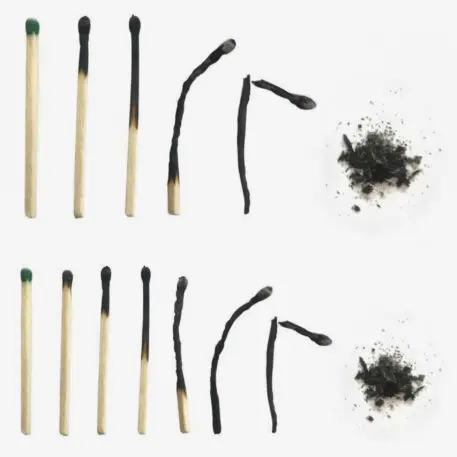A researcher from the University of Notre Dame this week unveiled a visual gauge that should help HR leaders quickly assess an employee’s level of workplace burnout. The assessment tool uses eight images of various levels of burnt matches that end with ashes. It’s akin to the cartoon smiley-face scale used by doctors to determine a patient’s pain level at the hospital and the happy faces used by companies to determine a customer’s satisfaction.
The matches could allow for a faster check-in than the comparatively more cumbersome assessments that HR leaders have used for decades to determine burnout. The Maslach Burnout Inventory has been one standard assessment, a 22-item survey that looks at exhaustion, cynicism, and a person’s feelings of incompetency at work.
Employers need a faster way to check in with employees without having to roll out a full survey, says Notre Dame business professor Cindy P. Muir (Zapata), the lead author who published data validating the measure this week in the Journal of Applied Psychology. “There’s something about the visualization of matches that just feels intuitive,” she says.

Physical and emotional exhaustion at work can evolve slowly—and it’s often the result of hundreds of micro stressors. When a person hits full-fledged burnout, the consequences can be dire: She may mentally check out, quit her job, suffer mental health and physical health problems, or turn to violence or even suicide.
Last year, more than half of workers said they were flaming out. Today at least a quarter of the 15,000 people across 15 countries that McKinsey Health Institute surveyed in August said they were experiencing burnout. People are still leaving their jobs because they’ve flamed out, and in some industries, such as education, healthcare, and retail, emotional exhaustion is getting worse, says Jennifer Moss, a journalist and author of the book The Burnout Epidemic.
“It’s still very much a real problem for a lot of people,” says Moss. People feel increased pressures around the return to office, more in-person meetings, the wave of recent layoffs, and talk of a potential recession. “People are feeling this level of expectation that they’re supposed to be over it. But they’re still very tired.”
As many as 89% of workers, 91% of HR leaders, and 82% of the C-suite say they are experiencing work-related stress, according to a new survey of 3,400 people by Workforce Institute at UKG and Workplace Intelligence. Nearly three-quarters of employees and of HR leaders and two-thirds of C-suite executives say work negatively impacts their personal life. And at least two-thirds of workers and HR executives and half of top executives say work stress negatively impacts their health and wellbeing.
Having a visual to measure burnout can be helpful, Moss says, because it could normalize and de-stigmatize burnout and encourage more people to talk about it and accept it. But burnout is a big, complex problem and employers, doctors, and society need a bigger plan to deal with it, she says.
The World Health Organization recently reclassified burnout in its International Classification of Diseases as an occupational syndrome resulting from “chronic workplace stress that has not been successfully managed.” Moss says that it should be classified as a medical condition, too, and employer standards, therapeutic strategies, and legal policy should follow to support and protect people suffering from it.
The Workplace Intelligence survey found that few people are talking to their employer about their exhaustion: 16% of employees never talk to their manager about workloads and 70% said they only discussed it every few months.
New research shows that burnout can be reduced more effectively with fewer job demands as opposed to just offering more mental health resources. “It’s not that employees need more social support, they need less work,” says Muir. Asking how people are doing is key, she says.
And a picture, she adds, may be worth a thousand words.
Recognize your brand’s excellence by applying to this year’s Brands That Matter Awards before the early-rate deadline, May 3.
